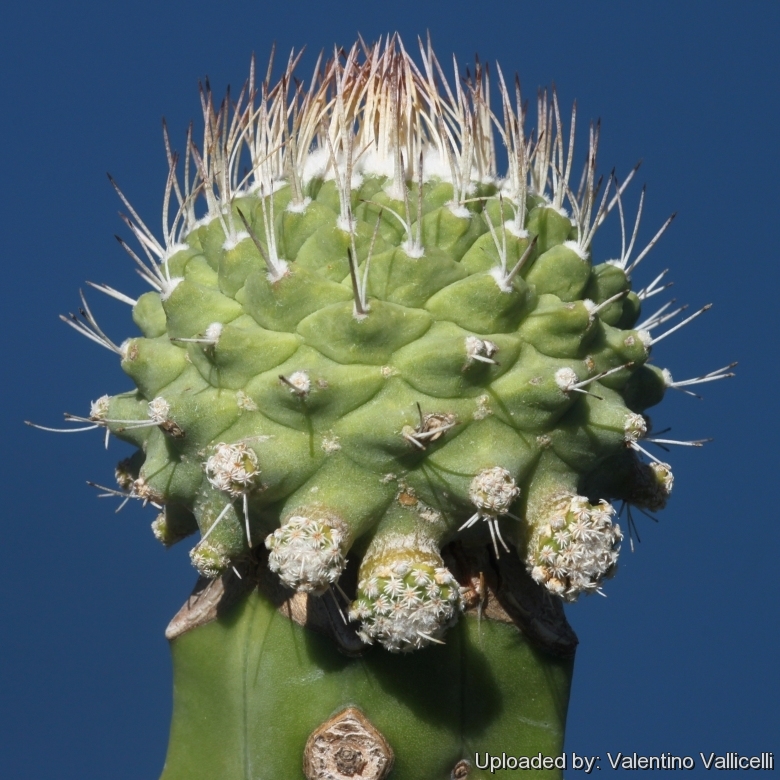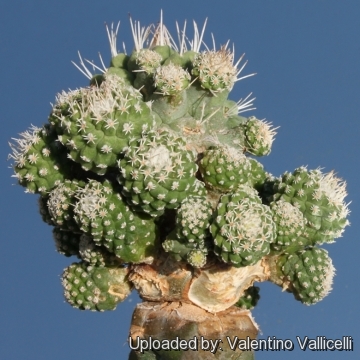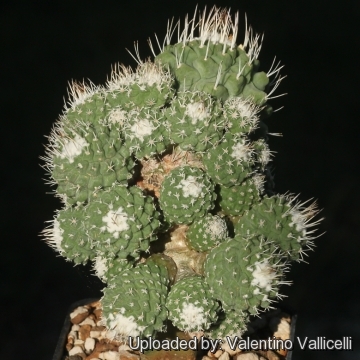
Strombocactus disciformis cv. Cespitosa Photo by: Valentino Vallicelli
Origin and Habitat: Horticultural sport (Cultivated variety)
Synonyms:
See all synonyms of Strombocactus disciformis
Description: This is a strange plant that forms lots of axillary shoots in a continuous series on almost each node starting from the base of the stem, while the typical Strombocactus disciformisSN|2103]]SN|2103]] is usually solitary.
Stem: The body is flattened or spherical, 3 to 8 cm high, reaching 20 cm in age, and 3 to 9 cm across and branches profusely from the base to form a crowded clump with hundred of small heads around the main stem. The crown is slightly depressed and felted. The colour is blue-green with greyish tinge, the base covered with brown corky spots in age. It is composed of hard, spirally arranged rhomboid and imbricate tubercles, 1 to 1.8 cm high. These tubercules are flattened and almost truncated above and somewhat horny or keeled below.
Spines: 4 to 5, erect and dark grey at the tips and pale grey at the base, 1.2 to 2 cm long, they become calcified, they are caducous and in age fall at the stem base.
Roots: Strong napiform (turnip-like).
Flower: Arise on the crown, measure about 3.5 cm in length and breadth, are shiny cream coloured with occasional spots at the tip and in the throat, The filaments are white or reddish, the anthers yellow. The 8 to 10 lobed stigma are white or yellowish.
Fruit: 7 mm across, splits down its length.
Seeds: Very small.
Blossoming time: Flowers emerge early in spring and are freely produced throughout the summer, remaining open for several days.
Subspecies, varieties, forms and cultivars of plants belonging to the Strombocactus disciformis group
 Strombocactus disciformis (DC.) Britton & Rose: the stem is flattened or spherical, blue-green with greyish tinge 3 to 8 cm high and 3 to 9 cm across. It is composed of hard, spirally arranged rhomboid tubercles that are flattened and almost truncated above.
Strombocactus disciformis (DC.) Britton & Rose: the stem is flattened or spherical, blue-green with greyish tinge 3 to 8 cm high and 3 to 9 cm across. It is composed of hard, spirally arranged rhomboid tubercles that are flattened and almost truncated above. Strombocactus disciformis f. cristatus hort.: Crested form.
Strombocactus disciformis f. cristatus hort.: Crested form. Strombocactus disciformis subs. esperanzae Glass & S.Arias: (= S. pulcherrimus) is very similar to S. disciformis the only noticeable difference is the colour of the flowers that are bright magenta.
Strombocactus disciformis subs. esperanzae Glass & S.Arias: (= S. pulcherrimus) is very similar to S. disciformis the only noticeable difference is the colour of the flowers that are bright magenta. Strombocactus disciformis subs. jarmilae (Halda) Halda: like S. disciformis but with a smaller body, small flowers, long thin spines and some other minor differences. Distribution: Northern Mexico (Querétaro and Nuevo León)
Strombocactus disciformis subs. jarmilae (Halda) Halda: like S. disciformis but with a smaller body, small flowers, long thin spines and some other minor differences. Distribution: Northern Mexico (Querétaro and Nuevo León) Strombocactus disciformis f. polytomicous hort.: Polytomy is a form of cristation, an apex divided in a lot of smaller apexes. It is very unusual to see such a Strombocactus.
Strombocactus disciformis f. polytomicous hort.: Polytomy is a form of cristation, an apex divided in a lot of smaller apexes. It is very unusual to see such a Strombocactus. Strombocactus disciformis cv. Cactus Art: odd monstrous plant forming crowded clumps or mounds, and most plants will crest readily. Areoles felt-like in relief 2-4 mm broad, greenish at the stems apex when young. Spines mumerous very short bristle-like.
Strombocactus disciformis cv. Cactus Art: odd monstrous plant forming crowded clumps or mounds, and most plants will crest readily. Areoles felt-like in relief 2-4 mm broad, greenish at the stems apex when young. Spines mumerous very short bristle-like. Strombocactus disciformis cv. Cespitosa: This is a strange plant that forms lots of axillary shoots in a continuous series on almost each node starting from the base of the stem, while the typical Strombocactus disciformis is usually solitary.
Strombocactus disciformis cv. Cespitosa: This is a strange plant that forms lots of axillary shoots in a continuous series on almost each node starting from the base of the stem, while the typical Strombocactus disciformis is usually solitary.
 Strombocactus disciformis cv. Cespitosa Photo by: Valentino Vallicelli
Strombocactus disciformis cv. Cespitosa Photo by: Valentino Vallicelli Strombocactus disciformis cv. Cespitosa Photo by: Valentino Vallicelli
Strombocactus disciformis cv. Cespitosa Photo by: Valentino VallicelliCultivation and Propagation: It is relatively easy to grow, but very slow growing. It is often seen as a grafted plant but grows very well on its own roots too. Needs a very well drained mineral substratum with little organic matter (peat, humus). Requires strong sun to part sun to develop good compact growth and waterings should be rather infrequent, to keep the plant flat shaped and not become excessively elongated and unnatural in appearance. Use Water sparingly from March till October and keep perfectly dry in winter, or when night temperatures remain below 10° C (but some people give this plant a light monthly watering to prevent the drying and shedding of the lower tubercles.) It is hardy to -4°C (or less) for a short period. In the rest period no high atmospheric humidity!! Ensure a good ventilation.
Propagation: Almost exclusively by grafting. Plants are grafted onto column-shaped cacti.












